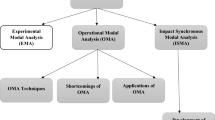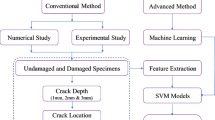Abstract
In this paper, the original receptance method first proposed by Bishop (The mechanics of vibration. Cambridge University Press, Cambridge, 1979) is further generalized and extended to the vibration modelling of stepped beams and truss structures with multiple crack damages. Cracks are physically treated as rotational springs representing local flexibilities at crack locations induced by crack depths. Frequency response functions (FRFs) with any given number of crack locations and depths are first established from which numerically exact natural frequencies and mode shapes are extracted. Since these FRFs can be measured in practice in a typical modal testing, a crack location method is then developed by using rotational FRFs which can be estimated from these measured translational FRF data. Substantial slope discontinuities are observed and are further employed to construct a crack location matrix to locate cracks. Finally, to identify crack parameters such as crack depths, a new Numerical Inverse FRF Sensitivity method is developed. Unlike the case of analytical model updating where an analytical model is available from which sensitivities can be derived, FRF sensitivities needed in this case have to be numerically computed. Such numerical sensitivity approach is believed to have wider applications in inverse dynamics problems such as analytical model updating. A stepped beam and a GARTEUR structure are employed in numerical case studies and very encouraging results have been achieved even when FRF data are contaminated with substantial measurement noise.

























Similar content being viewed by others
References
Bishop RED, Johnson DC (1979) The mechanics of vibration. Cambridge University Press, Cambridge
Gasch R (1993) A survey of the dynamic behaviour of a simple rotating shaft with transverse cracks. J Sound Vib 160(2):313–332
Dimarogonas AD (1996) Vibration of cracked structures: a state of the art review. Eng Fract Mech 55(5):831–857
Irwin GR (1957) Analysis of stresses and strains near the end of a crack traversing a plate. J Appl Mech 24:361–364
Freund LB, Hermann G (1976) Dynamic fracture of a beam or plate in plane bending. J Appl Mech 76:112–116
Liebowitz H, Vanderveldt H, Harris DW (1967) Carrying capacity of notched column. Int J Solids Struct 3:489–500
Rizos PF, Aspragathos N, Dimarogonas AD (1990) Identification and crack location and magnitude in a cantilever beam from the vibration modes. J Sound Vib 138(3):381–388
Ostachowicz WM (1991) Analysis of the effect of crack on the natural frequencies of a cantilever beam from the vibration modes. J Sound Vib 150(2):191–201
Fernandez-Saez J, Navarro C (2002) Fundamental frequency of cracked beams in bending vibrations: an analytical approach. J Sound Vib 256(1):17–31
Chondros TG (2001) The continuous crack flexibility model for crack identification. Fatigue Fract Eng Mater Struct 24(10):643–650
Caddemi S, Calio I (2009) Exact closed-form solution for the vibration modes of the Euler–Bernoulli beam with multiple open cracks. J Sound Vib 327:473–489
Lu ZR, Law SS (2009) Dynamic condition assessment of a cracked beam with the composite element model. Mech Syst Signal Process 23:415–431
Bachschmid N, Pennacchi P, Tanzi E (2010) A sensitivity analysis of vibrations in cracked turbogenerator units versus crack position and depth. Mech Syst Signal Process 24:844–859
Han Q-K, Chu F-L (2011) Local flexibility of an elliptical shaft under bending and tension. Mech Syst Signal Process 25:3198–3203
Caddemi S, Calio I (2013) The exact explicit dynamic stiffness matrix of multi-cracked Euler–Bernoulli beam and applications to damaged frame structures. J Sound Vib 332:3049–3069
Attar M, Karrech A, Regenauer-Lieb K (2014) Free vibration analysis of a cracked shear deformable beam on a two-parameter elastic foundation using a lattice spring model. J Sound Vib 333:2359–2377
Owolabi GM, Swamidas ASJ, Seshadri R (2003) Crack detection in beams using changes in frequencies and amplitudes of frequency response functions. J Sound Vib 265:1–22
Peng ZK, Lang ZQ, Billings SA (2007) Crack detection using nonlinear output frequency response functions. J Sound Vib 301:777–778
Rosales MB, Filipich CP, Buezas FS (2009) Crack detection in beam-like structures. Eng Struct 31(10):2257–2264
Perera R, Fang S-E, Huerta C (2009) Structural crack detection without updated baseline model by single and multiobjective optimization. Mech Syst Signal Process 23:752–768
Chatterjee A (2010) Structural damage assessment in a cantilever beam with a breathing crack using higher order frequency response functions. J Sound Vib 329:3325–3334
Zhong SC, Oyadiji SO (2011) Crack detection in simply supported beams using stationary wavelet transform of modal data. Struct Control Health Monit 18(2):169–190
Li H, Zhang Y-P, Zheng H-Q (2011) Application of Hermitian wavelet to crack fault detection in gearbox. Mech Syst Signal Process 25:1353–1363
Varney P, Green I (2012) Crack detection in a rotor dynamic system by vibration monitoring—part II: extended analysis and experimental results. J Eng Gas Turbine Power 134(11):1–10
Andreaus U, Baragatti P (2012) Experimental damage detection of cracked beams by using nonlinear characteristics of forced response. Mech Syst Signal Process 31:382–404
Assaashari E, Sinha JK (2014) Development of residual operational deflection shape for crack detection in structures. Mech Syst Signal Process 43:113–123
Narkis Y, Elmalah E (1996) Crack identification in a cantilever beam under uncertain end conditions. Int J Mech Sci 38(6):499–507
Faverjon B, Sinou J-J (2008) Robust damage assessment of multiple cracks based on frequency response function and the constitutive relation error updating method. J Sound Vib 312:821–837
Ye J-J, He Y-M, Chen X-F, Zhai Z, Wang Y-M, He Z-J (2010) Pipe crack identification based on finite element method of second generation wavelets. Mech Syst Signal Process 24:379–393
Singh SK, Tiwari R (2010) Identification of a multi-crack in a shaft system using transverse frequency response functions. Mech Mach Theory 45:1813–1827
Becerra JA, Villanueva F, Jimenez Espadafor F, Cruz-Peragon F, Torres Carcia M (2011) A methodology for crack identification in large crankshafts. Mech Syst Signal Process 25:3168–3185
Attar M (2012) A transfer matrix method for free vibration analysis and crack identification of stepped beams with multiple cracks and different boundary conditions. Int J Mech Sci 57:19–33
Kudela P, Radzienski M, Ostachowicz W (2015) Identification of cracks in thin-walled structures by means of wavenumber filtering. Mech Syst Signal Process 50–51:456–466
Lin RM, Ewins DJ (1994) Analytical model improvement using frequency response functions. Mech Syst Signal Process 8(4):437–458
Lin RM, Zhu J (2007) Model updating of damped structures using FRF data. Mech Syst Signal Process 20(8):2200–2218
Ohayon R et al (1997) Finite element updating of structural vibrations using numerical experimental simulations, GARTEUR Technical Report SM/AG-11 TP-095
Lin RM, Lim MK, Du HJ (1995) Improved inverse eigensensitivity method for structural analytical model updating. J Vib Acoust 117(2):192–198
Lin RM, Lim MK (1997) Relationship between improved inverse eigensensitivity and FRF sensitivity methods for analytical model updating. J Vib Acoust 119:354–362
Kwon Kye-Si, Lin Rong-Ming (2004) Frequency selection method for FRF-based model updating. J Sound Vib 278:285–306
Author information
Authors and Affiliations
Corresponding author
Rights and permissions
About this article
Cite this article
Lin, R.M. Modelling, detection and identification of flexural crack damages in beams using frequency response functions. Meccanica 51, 2027–2044 (2016). https://doi.org/10.1007/s11012-015-0350-6
Received:
Accepted:
Published:
Issue Date:
DOI: https://doi.org/10.1007/s11012-015-0350-6




